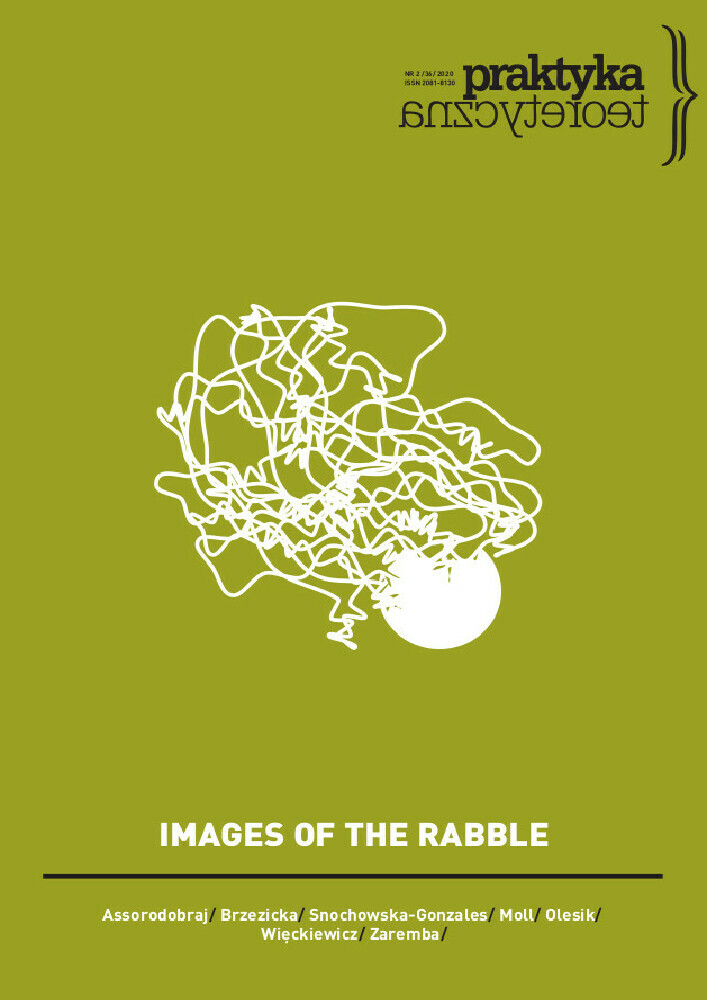Abstract
The author interprets the figures of European workers and colonized Africans presented as slaves of capitalism and imperialism, the image that circulated in the social and cultural imagination in Germany after the Berlin Conference (1884-1885). The aim of the article is to introduce the concept of “counterimagination” and show how the image of the rabble became juxtaposed with a visualization of the black slave. The author argues that both figures were considered to be a real threat to the German social order and to German Kultur, and concentrates on the popular images of the “other” circulating in the German visual culture after 1880. The first part of the article is devoted to the aesthetics of the weekly satirical magazine Simplicissimus founded in April 1896. In the second part, the aggressive propaganda campaign against the Occupation of the Rhineland by French colonial troops is discussed. The author describes the mechanisms of envisioning black soldiers and points out the anticolonial reactions to the “Black Shame” campaign.
References
Allen, Ann Taylor. 1984. Satire and Society in Wilhelmine Germany. Kladderadatsch and Simplicissimus 1890-1914. Kentucky: The University Press of Kentucky.
Anderson, Benedict. 1996. L’imaginaire national. Réflexions sur l’origine et l’essor du nationalisme. Transl. by Pierre-Emmanuel Dauzat. Paris: Édition la Découverte.
Blackshire-Belay, Carol Aisha. 1996. The African-German Experience. Critical Essays. Connecticut-London: Praeger.
Burmeister Ralf. 2007. Hannah Höch. Aller Anfang ist DADA. Bonn-Ostfildern: Berlinische Galerie, Hatte Cantz Verlag.
Campt, Tina. 2004. Other Germans. Black Germans and the Politics of Race, Gender, and Memory in the Third Reich. Ann Arbor: The University of Michigan Press.
Campt, Tina. 2003. “Converging Spectres of an Other Within. Race and Gender in Prewar Afro-German History.” Callaloo vol. 26/2.
Collar Peter. 2013. The Propaganda War in the Rhineland. Weimar Germany, Race and Occupation after World War I. London-New York: I.B. Tauris.
Elias, Norbert. The Civilizing Process, Vol. I. The History of Manners. Oxford: Blackwell, 1969. Simplicissimus. 1898-1907. http://www.simplicissimus.info/index.php?id=6.
Frierichsmeyer, Sara and Susanne Zantop. 2011. The Imperialist Imagination. German Colonialism and Its Legacy. Ann Arbor: The University of Michigan Press.
Garsha, Jeremiah. 2014. “Picturing German Colonialism. Simplicissimus special 1904 issue.” Przegląd Zachodni vol. 1.
Gilman, Sander L. 1985. “Black Bodies, White Bodies. Towards the Iconography of Female Sexuality in Late Nineteenth-Century Art, Medicine and Literature.” Critical Inquiry vol. 12/1.
Gründer, Horst, i Hermann Hier. 2017. Die Deutschen und Ihre Kolonien. Ein Überblick. Berlin: be.bra Verlag.
Mirzoeff, Nicholas. 2011. The Right to Look. A Counterhistory of Visuality. Durham-London: Duke University Press.
Mitchell, W. J. T. 2012. Seeing through Race. Cambridge-London: Harvard University Press.
Mühlhahn Klaus. 2019. Making China Modern: From the Great Qing to Xi Jinping. Cambridge: Harvard University Press.
Naranch, Bradley and Geoff Eley. 2014. German Colonialism in a Global Age. Durham-London: Duke University Press.
Rancière, Jacques. 2004. The Politics of Aesthetics. The Distribution of the Sensible. Transl. by Gabriel Rockhill, London-New York: Continuum International Publishing Group.
Taylor, Charles. 2004. Modern Social Imaginaries. Durham-London: Duke University Press.
Weir, Todd. 2010. “Between Colonial Violence and Socialist Worldview: The Conversion of Ernst Däuming.” German History vol. 28.
Sobich, Frank Oliver. 2006: Schwarze Bestien, rote Gefahr: Rassismus und Antisozialismus im deutschen Kaiserreich. Frankfurt-New York: Campus Verlag.
Wigger, Iris. 2010. “‘Black Shame’. The Campaign Against ‘Racial Degeneration’ and Female Degradation in Interwar Europe.” Race & Class vol. 51/3.
Wigger, Iris. 2017. The Black Horror on the Rhine. Intersections of Race, Nation, Gender, and Class in 1920s Germany. London: Palgrave Macmillan.
License
“Theoretical Practice” seeks to put into practice the idea of open access to knowledge and broadening the domain of the commons. It serves the development of science, thinking and critical reflection. The journal is published in open-access mode under the CC-BY-NC-SA 4.0 license (detail available here: http://creativecommons.org/licenses/by-nc-sa/4.0/). Articles published in the journal may be freely distributed, stored, printed and utilized for academic and teaching purposes without restrictions.
They should not be, however, used for any commercial purposes or be reconstructed into derivative creations. Access to the journal may not be limited or offered for a fee by any third party.
Prospective authors are obliged to fill in, sign and send back the publishing contract compliant with the CC licencing. [PL.pdf, PL.doc, EN.pdf,EN.doc].
According to this contract, authors grant the journal a non-exclusive right to publish their work under the creative commons license (CC-BY-NC-SA 4.0) without any financial obligation on both sides of the contract.
Before submission authors should make sure that derivative materials they use are not protected by copyright preventing their non-commercial publication. Authors are responsible for any respective copyright violations.
